Interview: Photographer + All Walks Contributor Annabel Staff

Many unsung heroes shape All Walks Beyond the Catwalk, and Annabel Staff is one of them; specializing in live music and social documentary photography, her expert eye ensures that every All Walks event is captured and communicated with pictorial genius.
With recent credits including our trip to the House of Commons for the Miss Representation Screening, we caught with Annabel to meet the lady behind the lens...
All Walks: What first sparked your interest in photography?
My dad. When I was young, there would always be my dad’s cameras dotted around the house, and I would pick them up and look through the viewfinder and be so amazed at how the world would look through the lens. Dad was really passionate about photography, and really nurtured my interest in it, I really do have him to thank, he’d be very impressed with how far I have come.
AW: Tell us something that we don’t know about live music photography?
You only ever get to shoot the first three songs of any gig and it’s not half as glamorous as people think it is, but it is a lot of fun!
AW: How do you convey the atmosphere of a live gig in a single shot?
Well…that’s a complex question! One thing it’s really important to concentrate on is expression, you really have to capture the artist at the peak of their emotions while they are performing, which can be a fleeting moment so it requires a lot of concentration.
AW: When did you first become involved with All Walks Beyond the Catwalk?
In 2010, I met the lovely Debra at an event I was shooting, I was drawn to her pretty awesome Keith Haring T-shirt and we started chatting, and she told me about All Walks, I stayed in touch and got more and more interested in the initiative and offered my help if it was needed. Everyone involved is so passionate and great to be around, it really has a positive influence and I love getting involved in something so positive.
AW: You’ve shot an assortment of different women for All Walks, how do you communicate their individual personality though a picture?
I’m a bit of a “sit back and see” photographer I would suppose, it’s best not to get too involved in directing people around, rather let the person relax and chat before taking the photographs. I always like to shoot quickly, I think you will always capture the personality within the first few shots, if you take too long you lose people as they may start to get self conscious in front of the camera.
AW: All Walks recently hosted the Miss Representation screening at the House of Commons; did you enjoy shooting the event?
Really enjoyed it! Great to see so many diverse people in one place, all connecting to a shared vision, getting involved and watching all the conversations happening. You could tell that the event really struck a chord with everyone there.
AW: What do you love the most about your job?
The variety. One day I will be photographing events, the next I’ll be shooting portraits, in the evenings I’m shooting music, the next day I may be in the studio, the next week I’ll be photographing in France maybe, or for instance, the other day I was up at an unearthly hour to do production shots for a radio station broadcasting from the set of Harry Potter.
AW: You photograph such an eclectic range of subjects; how important is diversity to you when shooting?
Ah well I think I just answered that above! It’s so important. I love working with people, I love meeting people, and making people smile – which although sounds horribly cheesy, it’s what makes it all worthwhile, when I get feedback to say that I’ve really captured a feeling or emotion, it really is the best compliment. Also, I need variety for my personality, I don’t like to be stuck on one thing for too long, I like to keep moving and keep exploring, coming up with new ideas, so variety really is key.
AW: What’s next for Annabel Staff?
Well, who knows, the world is your oyster (I am I really full of so many clichés?!), I really believe that. If you believe in yourself you can do whatever your heart desires, so, I am concentrating on where I want to be next – but I am pretty sure it involves a bit of a switch in the direction of my photography, I’m keen to shoot something new that I have never done before, I have some ideas, but I am nurturing them at the moment. I definitely want to travel more with my work as well, it’s a big beautiful world out there and it seems crazy to stay in one place when there is so much out there to see and experience.
***
Interview by Charmaine Ayden
Editor Charlotte Gush, on Twitter @CavaCharlotte
***
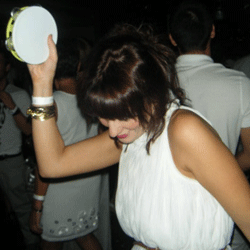 |
Charmaine Aydenis a Fashion Communication graduate from Northumbria University. An avid admirer of all things ‘glossy’, she set her heart on a career in Fashion Journalism from a young age. Having undertaken work placements with Vogue, WSGN, ASOS, Drapers and Glamour Magazine, Charmaine is currently working as Copy and Features Writer for Brownsfashion.com. Check out Charmaine’s blog The Good is the Beautiful and find her on Twitter @CharmaineAyden |
Interview: Make-Up Maestro Kay Montano talks Beauty and Diversity

Self-described as a ‘Trojan Horse,’ make-up artist Kay Montano is a modern-day feminist with a passion for diversity; displaying an aversion to ‘born Barbie’ culture, she’s definitely not interested in ‘keeping up with the Kardashians’.
Sandwiched between her feminist views and the aesthetically orientated world of make-up, Kay carefully balances the two seemingly contradictory forces:
"Make-Up needn’t be seen as corrective or something to hide behind. I see it as another form of expression and acceptance, even pleasure, of being in your own skin. It’s too easy and too unintelligent to say that wearing make-up means that you’re not empowered. Being a feminist has got nothing to do with what you look like, you could wear make-up, high-heels and have your tits out and still be a feminist.
Sexuality is normal and bodies are nothing to be ashamed of - we learn that it's really all about having awareness of your true intentions. You shouldn't have to hide yourself to be treated as a normal human being. Whether or not to see this freedom an act of sexual submission or sartorial freedom (whether an observer or participant) is all about your own reasons for viewing and participating. As we know, nudity is viewed by different cultures entirely differently, according to what is learned there."
With over twenty years experience within the fashion and beauty industries, Kay has observed representations of the female form morph from a spectrum of ideals to the promotion of an increasingly narrow physical archetype:
"I think that society has regressed back to a really limited stereotype of women, relying on regressive laddish fantasies of 'processed' sexuality, where women look like a cross between little girls and porn stars."
Naming a collection of beauty icons including Anjelica Huston and Lauren Hutton, Kay insists that it’s the imperfections that make us unique and beautiful:
"All my beauty icons have got something a little strange about them, but that’s what makes them exceptional. It’s easier to say what beauty doesn’t mean to me, rather than what it does. It’s not exclusive to any age, race or gender, and it’s not about suffering, oppression or fitting in."
Urging young woman to aspire to alternative role models and reject ‘Kardashian culture’, Kay believes that contemporary feminism comes in the unlikeliest of packages:
"There are so many women who are threatened by the silly notions of what feminism is. The reason I can [now] be so self-assured is that when I grew up I had so many feminist role models. Paula Yates and Gloria Steinem would write gutsy and sassy columns in Cosmopolitan magazine; I was brought up to believe that feminism was seriously hot, so it’s such a shock to see that everyone has gone so 'Kardashian'. More girls should be looking to young women like Tavi Gevinson, who’s speaking to teenagers in a positive way. I love how she writes in Rookie Magazine; she’s young, stylish and talks candidly about being a feminist."
Saluting its co-founders Caryn, Debra and Erin, Kay considers All Walks Beyond the Catwalk to be an integral piece of the jigsaw puzzle in order to reform body image perceptions and appreciate diversity:
"All Walks Beyond the Catwalk has evolved from an earnest movement, to something that’s happening all over the world. The girls have really done their groundwork and have been trailblazers for the cause; I admire them for that. It’s very hard for people in the industry to come forward. People don’t like upturning the apple cart, but All Walks haven’t been afraid to do that."
***
Interview by Charmaine Ayden
Editor Charlotte Gush, on Twitter @CavaCharlotte
***
 |
Charmaine Ayden is a Fashion Communication graduate from Northumbria University. An avid admirer of all things ‘glossy’, she set her heart on a career in Fashion Journalism from a young age. Undertaking work placements with Vogue, WSGN, Asos, Drapers and Glamour Magazine, Charmaine is currently working as Copy and Features Writer for Brownsfashion.com. Check out Charmaine’s blog The Good is the Beautiful and find her on Twitter @CharmaineAyden |
Interview: Hannah Marshall on Powerful Women, Icons, Muses & Friends
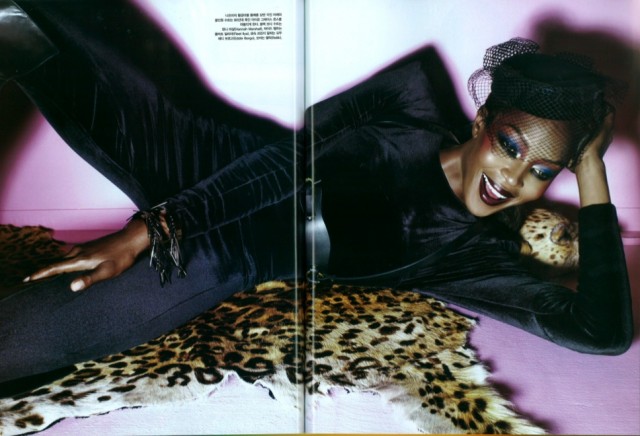 Naomi Campbell wearing Hannah Marshall in Vogue Korea, August 2009
Naomi Campbell wearing Hannah Marshall in Vogue Korea, August 2009AW: Your collections convey a sense of female empowerment, how do you achieve this?
HM: I am constantly inspired by strong women such as Grace Jones, Siousxie Sioux, Tilda Swinton and Bjork; women that are unique, powerful, have conviction, integrity, a sense of strength and inner confidence.
Clothing is one of the strongest tools of communication, and I design clothes that empower women through sharp minimalist silhouettes, constructed from sleek but tactile fabrications, in any colour that fits into the monochromatic rainbow.
AW: In past collections youʼve explored the visual collaborations between Grace Jones and Jean Paul Goude, as well as body modification, can you tell us a little more about this?
HM: Pre-digital era, the legendary art director Jean-Paul Goude was a pioneer. My collection entitled “Army of Me” examines methods of attenuating and empowering the female form through designs that evoke the superhuman inuendo of his body of work. The sleek, androgynous persona of his former muse Grace Jones epitomises the very essence of the Hannah Marshall woman.
 Florence Welch of Florence and the Machine wears Hannah Marshall
Florence Welch of Florence and the Machine wears Hannah Marshall AW: Youʼve expressed your love for the shade of black, whatʼs so powerful about this colour?
HM: Black has its own code.
Black can hide well.
Black demands attention.
Black is the most powerful colour that exists.
Black says everything but gives nothing away.
Black is the strongest colour that defines the silhouette.
AW: How do women tend to respond to when wearing your garments?
HM: My designs almost have a transformative quality to them, rendering the female body to create a sharper silhouette that makes the wearer feel confident and on the sensual side of sexy, without being vulnerable.
 Beth Ditto of the band The Gossip wears Hannah Marshall
Beth Ditto of the band The Gossip wears Hannah MarshallAW: Youʼve earned a host of influential fans including Florence Welch, Beth Ditto, Naomi Campbell and Tori Amos; are you excited that such a diverse group of women have all responded to your designs?
HM: The women that wear my designs are incredibly diverse and their only common quality is their difference.
The most exciting moment has to be seeing the iconic cover of Wonderland magazine with the incredible Janet Jackson wearing the Spine Sleeve Dress that was custom made especially for her. I am a huge fan of all music ending with the surname Jackson, so I am very proud of this and thankful to the amazing Anthony Unwin for asking me to create a piece.
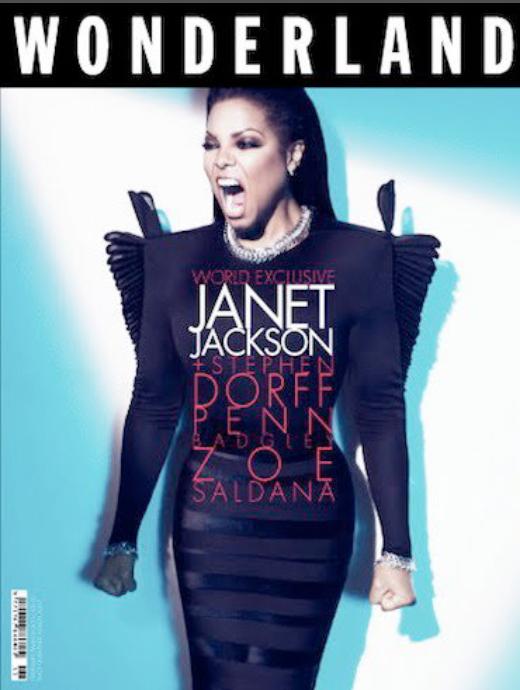 Janet Jackson wearing Hannah Marshall for the cover of Wonderland Magazine
Janet Jackson wearing Hannah Marshall for the cover of Wonderland MagazineI have dressed Florence and the Machine for performances, photo shoots and videos but I think the most exciting time for me was creating a custom designed leather, crystal and chiffon bodysuit that she wore in the Drumming video directed by the legendary Dawn Shadforth and styled by Aldene Johnson. I love creating special pieces for artists such as Florence, since not only do they come to life and give the piece a heartbeat, but, my work is digitally immortalised.
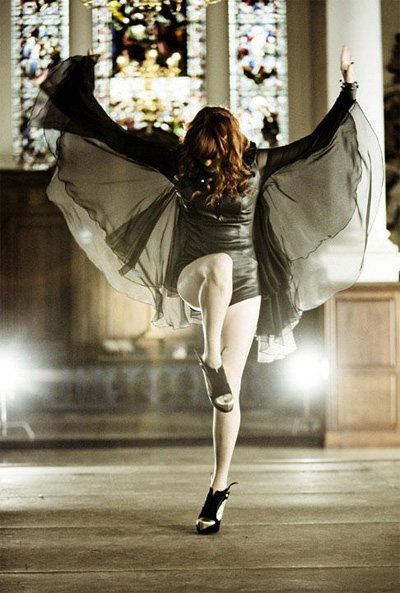 Florence Welch of Florence and the Machine wears Hannah Marshall in the video for Drumming
Florence Welch of Florence and the Machine wears Hannah Marshall in the video for Drumming The piece I produced for the pilot season of All Walks Beyond the Catwalk has a similar feel to it in the way it moved on the body. I purposely wanted an older woman to wear my design to prove that style is about much more than age, but a certain attitude and confidence in your own skin. The ever-beautiful Valerie Pain was the perfect woman to collaborate with, tall, elegant, beautiful – and 70.
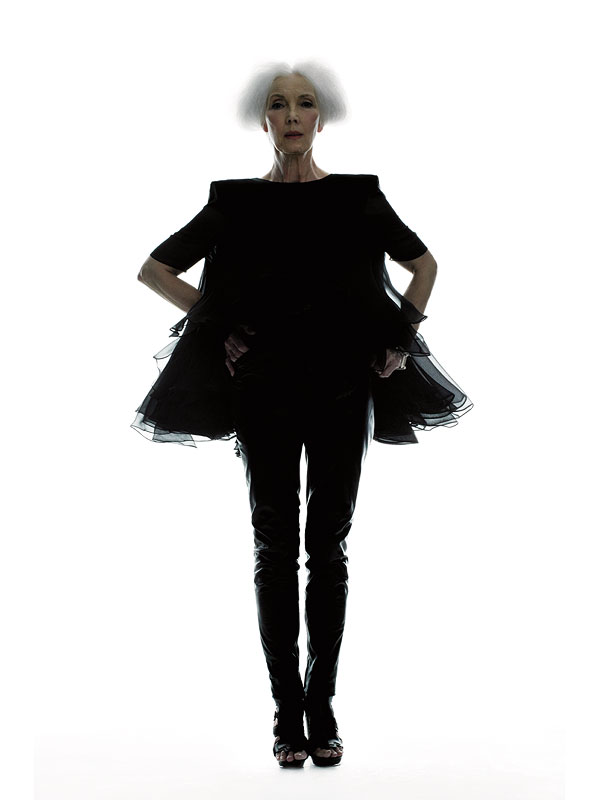 Valerie Pain wearing Hannah Marshall for All Walks Beyond the Catwalk
Valerie Pain wearing Hannah Marshall for All Walks Beyond the Catwalk AW: Youʼve previously cited All Walks co-founder, Erin OʼConnor as your muse, how does she inspire you?
HM: Erin modeled exclusively in my very first catwalk show at London Fashion Week and she fitted the role perfectly – she strikes the fine balance between strength and elegance. Erin has actually become a really good friend to me over the past few years, so to me, I no longer only look at her as this incredible British supermodel, because getting to know Erin I can say she is incredibly intelligent, talented, generous, inspiring, trustworthy, loyal and warm person.
Stylist magazine put Erin and I on the front cover of their Fashion Issue, photographed by John-Paul Pietrus which featured an interview about our dual relationship as both designer and muse but also as great friends. I love the way that Erin is unapologetic and the way she reminds me to be unapologetic.
AW: Whatʼs next for Hannah Marshall?
HM: I recently decided not to show seasonal collections on the catwalk, but instead, explore territory around and outside of the fashion sphere. I am currently working on some exciting and innovative projects and crossover collaborations, I can't reveal too much at the moment but - watch this space! The main thing for me is that I want to continue to express my creativity in and outside of the fashion sphere, as it goes beyond the catwalk.
***
Interview by Charmaine Ayden
Images courtesy of Hannah Marshall
Editor Charlotte Gush, on Twitter @CavaCharlotte
***
 |
Charmaine Ayden is a Fashion Communication graduate from Northumbria University. An avid admirer of all things ‘glossy’, she set her heart on a career in Fashion Journalism from a young age. Undertaking work placements with Vogue, WSGN, Asos, Drapers and Glamour Magazine, Charmaine is currently working as Copy and Features Writer for Brownsfashion.com. Check out Charmaine’s blog The Good is the Beautiful and find her on Twitter @CharmaineAyden |
Interview: Samantha Donnelly on her Exhibition ‘Contour States’
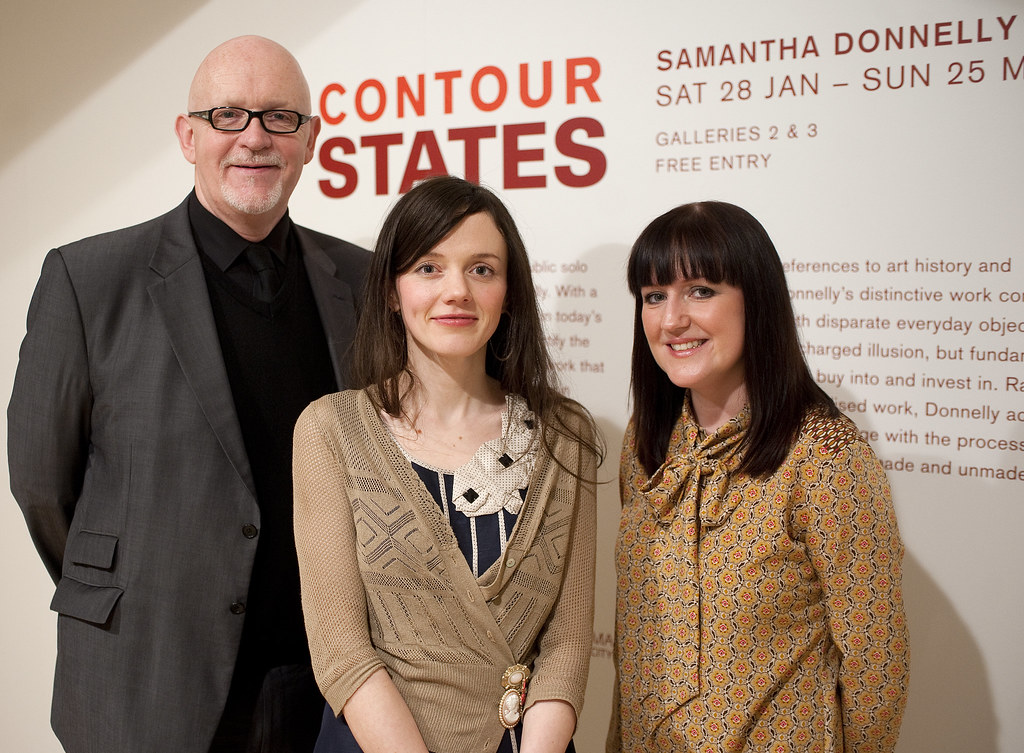
Samantha Donnelly (centre) at the opening of her exhibition "Contour States" at The Cornerhouse, Manchester
AW: The exhibition literature notes that your work is “concerned with the powerful effects of media imagery on the individual, and in particular with how the portrayal of women in the media shapes and defines them”. How do you think their portrayal in the media shapes and defines women?
SD: Throughout the show there are a series of gestures or points which edit or place ideas of what individuals were thought as, might be thought of as, may be, or may read themselves as. So, in a way the exhibition as a whole presents a platform where people (male, female and trans-gendered) can choose to re-read themselves in relation to objects, or choose not to. It’s not my position as an Artist to dictate, just to offer or present possibilities for an audience to interpret.

Outlining Venus (2012) Jablite, wood, emulsion paint, clamps, supatex latex fabric, acrylic paint, collage, card, steel, satin ribbon, gold schlag leaf, fablon, vinyl, MDF, paper, hazard tape, clamp, giclee print, acrylic, beef olive skewer, pastel Unique object 380 cm (l) x 240 cm
AW: Your installations include fashion magazines. What effect do you think the fashion industry has on the accepted female 'ideal'?
SD: Fashion magazines are only one reference point in a sea of images. Images and representations are as old as time, take for example the Venus piece upstairs that quotes from the Venus de Willendorf (22,00 - 24,000 BCE). This is a stark contrast to the bottom image of Venus de Milo, the Greek Goddess of Love and Beauty.
As a woman I am interested in how people connect to representations of femininity or ideals. But I feel that the work, and the exhibition as a whole, has many other concerns of 'shaping', such as Capitalism, Mass-production and Economies, Art and Art history, the Individual and the group, Philosophy, Mortality.
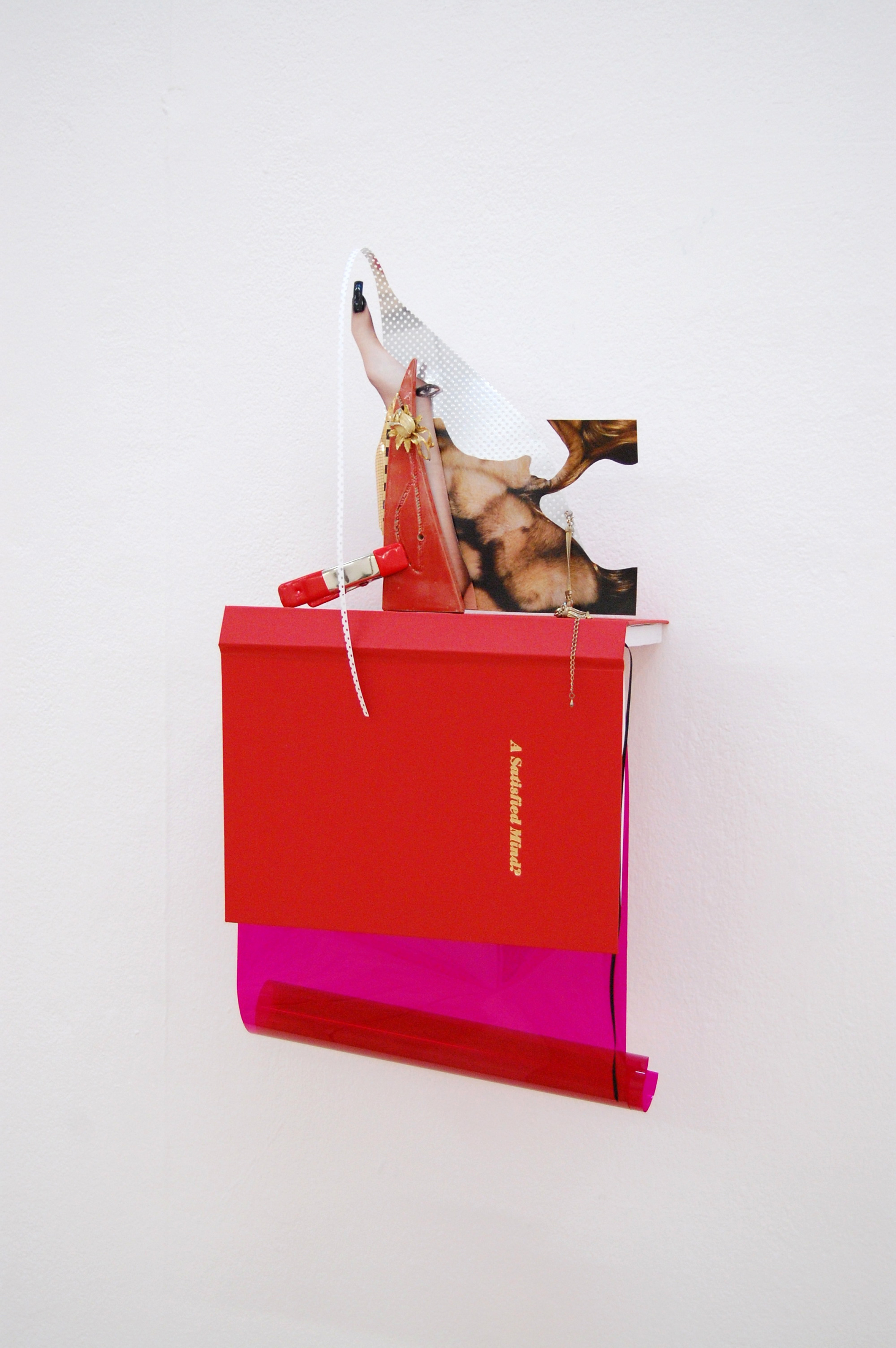
Method Act / City Limits (2012) Unique object: Glazed stoneware, clip, plastic, card, collage with original inks from publication, found gilded brooch, gluing clamp, bracelet, false nail, blu-tack, hand-bound fabric book, lighting gel. 32 cm (l) x 25 cm (d) x 70 cm (h)
AW: Your piece entitled 'Method Act / City Limits' includes what are generally considered aesthetically pleasing items, such as jewellery and an image of an eye with make-up, as well as seemingly fetishised images, like the long black fingernail and pink latex material. These items are balanced on top of a book, the cover of which poses the question 'A Satisfied Mind?' What do you think of the balance of concern in society and in the media for achieving a satisfying appearance and a satisfied mind?
SD: The title comes from Johnny Cash song, which is actually more concerned with Capital (money) as a form of satisfaction or being poor in money yet rich in emotional or spiritual 'value'. So for me the work is about values and the desire for shiny or covetable things, and the drive for these which seems precarious.
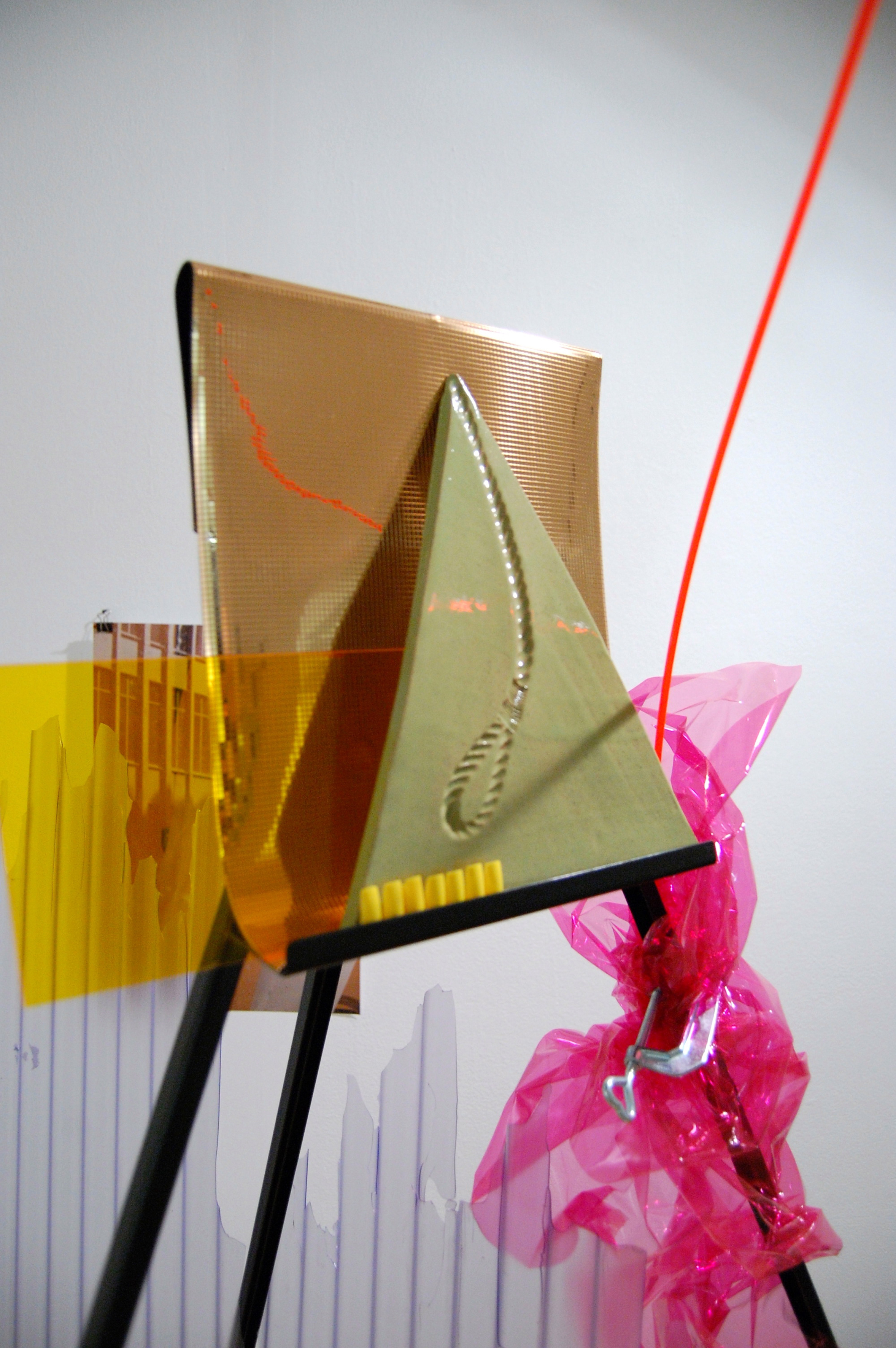
Detail (2012) Unique object: Glazed stoneware, powder coated steel, PVC, plastic nails, corrugated plastic sheet, steel clamp, acrylic, fold-back clip, perspex rod, magazine, plastic wallet, elastic bands, imitation leather belts, fabric, Giclee print, acrylic paint, emulsion paint, wood 140 cm (l) x 190 cm (d) x 240 cm (h)
AW: With your background as a student of Time Based Arts, I was intrigued when you told me the clamps used to hold parts of the installations together signified the temporal nature of their relationships. There are also a lot of smashed or shattered objects in the exhibition, similarly suggesting changing states. Do you think the representation of women and their minds and their sexuality has changed, or is changing, or will change in the future?
SD: I'm fairly sure I'm not qualified to answer! I think talking about the 'whole' and of 'women' is kind of blanketing over a history with one story, with a new blanket that’s kind of, well, exactly the same. There are many different 'women's' today, not just one movement with one aim, but a pluralism of individuals who all have different objectives. Change is inevitable over time in any realm, so yes, I think representations of women will change, just as the European Union will change and as Capitalism will undoubtedly alter.

Contortionist (2012) Stained earthenware, varnish, glaze, wood, plaster, pigment, acrylic, mirror, C-type prints, Sculpey, copper tube, supatex latex, electrical tape, aluminum clamps, steel clamps, fabric bound book, lighting gels, collage using original inks from publication, metal chains, acrylic nails, modeling wax, acrylic tube, tights, buttons, earrings, VHS film, neon fablon, MDF, paint, velcro, perforated steel sheet, aluminum film Unique object 403 cm (d) x 320 cm (w) x 205 cm (h)
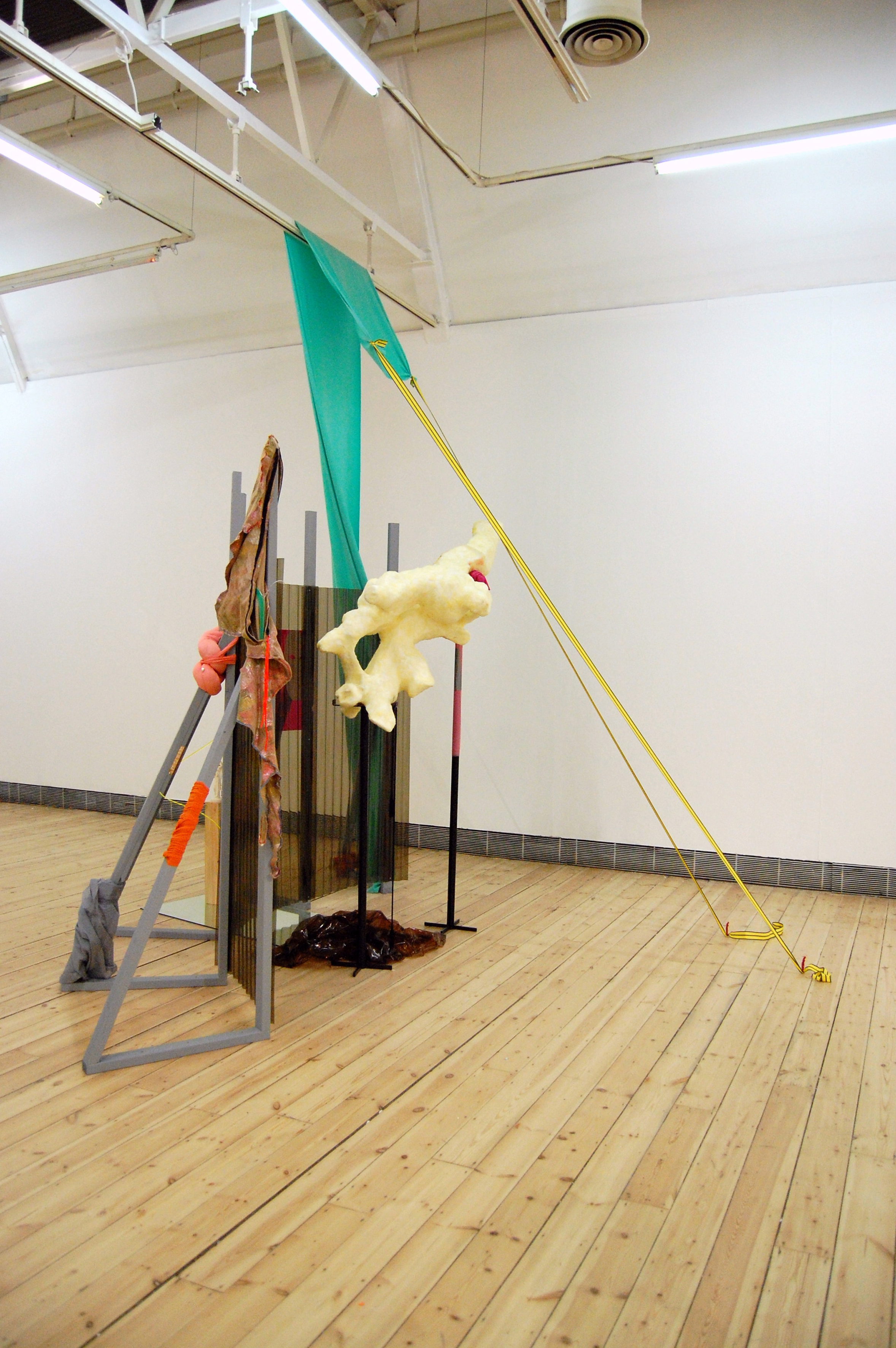
Illusions of Supersaturation (2012) Unique object: Polystyrene female sport mannequins, jesmonite, plaster bandage, modeling wax, coloured beeswax, powder coated steel, timber, corrugated sheeting, supatex latex, polyester webbing, plastic covered hooks, nylon tights, polyester wadding, simulated pearl earring, cloth tape, glitter flecked corduroy, zip, lycra top, lighting gel, tie-back, coat hanger, foam, glazed stoneware ceramic, electrical tape, photocopy, found carved statuette, mirror, fabric, PVC, ribbon, neon acrylic rod, fold-back clip, C-type print 370 cm x 370 cm x 370 cm
***
Interview by Charlotte Gush
All images courtesy of the Artist and Ceri Hand Gallery
Samantha Donnelly's exhibition 'Contour States' is at The Cornerhouse, Manchester, until Sunday 25th March 2012.
***
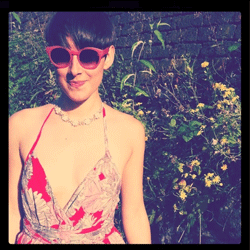 |
Charlotte Gush is a freelance fashion writer, blogger and editor based in Manchester, as well as the Online Commissioning Editor for All Walks. She has previously spent 6 months working for All Walks at the London office as a social media, marketing and production intern. Charlotte writes a fashion, street style and personal style blog, CAVACOMA.com, with a dedicated Facebook fanpage here, and a Twitter account @CavaCharlotte |
Interview: Elisha Smith-Leverock on her Award-winning Film ‘I Want Muscle’
Elisha Smith-Leverock is a filmmaker and photographer working in fashion and music. The All Walks team first met Elisha at a dinner hosted by The W Project. Our very own Caryn and Debra gave a presentation on the All Walks initiative, alongside accessory and prop designer Fred Butler, who presented her work and introduced us to the creatives she collaborates with. Elisha had created several short fashion films showcasing Fred's collections.Elisha's short film 'I Want Muscle' (below) was awarded the Grand Prize at the 2011 A Shaded View of Fashion Film Festival, held at the Center Pompidou in Paris. All Walks' Charmaine Ayden caught up with Elisha to discuss the film and to discover how Caryn and Debra's presentation at The W Project dinner influenced her to deal with the topic of beauty and diversity. - Ed.
'I want Muscle' a film by Elisha Smith-Leverock, Winner of the 2011 ASVOFF MK2 Grand Prix
Elisha, the film is so compelling, how have women responded?
There’s been a really positive reaction. A lot of people, even beyond the fashion audience, have been touched and affected by the content. Countless people have told me that they’ve never seen a female body-builder depicted in this way before, as they’re usually exposed as a kind of ‘freak show' event. For me, that’s not what female body-building is about. It’s beyond looking at someone and thinking ‘wow you look different’, it’s about what it means for the woman’s mental state and understanding why people feel so threatened and react so strongly.
I liked the idea of hooking people in with clichés. You’re expecting to see a film where a woman is passive and objectified, but instead you get physical strength, gruelling hard work and pure gorgeousness [laughs]!
How did you approach female body-builder Kizzy Vaines; was she initially interested, or did she have her doubts?
If she was hesitant, then I don’t think that the film would have worked. In fact, it seemed as if she was completely open to the idea, possibly because there’s an exhibitionist element about filming that appeals to her. We found Kizzy through a casting; it was really important for me to cast someone who was a completely natural body-builder and had achieved their physique through entirely hard work. Kizzy has a very apparent softness, she’s extremely beautiful and she combines both strength and vulnerability, that’s what appealed to me. She was just the perfect candidate [laughs].
How does I Want Muscle address gender stereotypes and body images taboos?
I Want Muscle started with the idea that men are supposed to be strong and muscular, and that women are perceived as being soft and feminine. The subject of body-building toys with that opinion, as the women involved in the sport are physically much stronger than most men. I believe that by showing a physically very strong woman, it challenges the notion that men are the stronger of the two sexes.
I Want Muscle was partly inspired by an All Walks speech at the W Project Dinner; can you tell us a little more about this?
Often when you’re involved in the fashion industry, you’re not always aware of the issues that other people are fighting against. You frequently just accept the established ‘wrongs’ and become a part of a ‘fashion bubble’. So when Caryn and Debra were talking about their intentions for All Walks Beyond the Catwalk, and how they’re attempting to introduce different types of women and bodies into a very close-minded industry, it just stuck with me.
There have been times when I’ve thought ‘well of course I could use a ‘different’ body-type for one of my fashion films’, but I haven’t entirely considered the implications that it has. For instance, many designers won’t consider lending garments to someone that isn’t a sample size, including a body-builder. The subjects that Caryn and Debra spoke about at The W Project dinner mulled around in my head along with some other catalysts, from that point the ideas just exploded into I Want Muscle.
You mention other inspirational catalysts, could you give us an example?
Diane Pernet had approached me for a project that didn’t end up happening. The theme of the film was power, and what we perceive as powerful. Although it didn’t happen, the idea still stuck with me and I wanted to continue with this idea for a film; it just seemed to spark something within me [laughs]. For me personally, the theme of power suggested how female physical strength can be extremely empowering.
I Want Muscle outlines the incredible physical and mental strength that female body-builders possess, how did Kizzy Vaines explain the motivation behind her strength?
I think that she just genuinely loves it, she likes being strong and she loves the sport, so that’s her motivation. She comes from a dance background, she’s a contortionist as well as dancer, and so she’s already possesses a driven and disciplined mindset. Her husband is a body-builder too, so together, I think that they achieve a lot.
While shooting, what common misconceptions about female body-building did you encounter?
Not so much misconceptions, just plain judgement. People can be very closed minded, cautious, ignorant or seemingly offended by her physique, and that truly puzzles me. In fact, while making the film I noticed how many people find physical strength or strong women repulsive. Before the shoot people commented with remarks such as ‘I find it a bit gross’, but after seeing Kizzy move so gracefully in the flesh, many of the girls said that they found her physique sexy and some even wished they could look like her.
The film includes pieces from David Koma, Husam El Odeh and Maria Francesca Pepe, why did you choose to profile these designers?
I Want Muscle was quite different to the other films that I make, as I didn’t work with a specific designer. It was really important that the main focus of the film was the character, not the clothes. Coming from a design background, I wanted to incorporate a fashion aesthetic, but I didn’t want ‘fashion’ to dominate the film. We used a mixture of designers, based on who was open-minded enough to lend us clothes. One of the key pieces was a harness that Kizzy was wearing. I’d discussed it with Kim Howells beforehand, as I felt that the harness juxtaposed the right mixture of resistance and elegance. We did have a particular aesthetic in mind and wanted the film to hark back to the golden era of female body-building, in the late 1970’s early 1980’s.
Diane Pernet and A Shaded View Of Fashion are extremely influential in the world of fashion film, how did it feel to win this years Grand Film Prize?
I felt really, really honoured. There were fifty films in the running and filmmakers that I absolutely worship created a lot of them. A Shaded View of Fashion has been such a great platform and something that I have grown with as a filmmaker. This is the first year that I’ve been in the competition, but Diane has screened a film of mine before.
Do you have any plans for a screening?
Yes, we’re hoping to get a screening in London and invite Kizzy down for a Q&A.; I want lots of people to see the film, because I hope that it will challenge their views. Women don’t come in one generic package, we’re all different shapes and sizes, and so for fellow women to accept Kizzy’s physical strength, well that’s a real achievement.
Where did your interest in fashion film and photography begin?
I studied photography, so my interest has evolved from that point. Initially I started taking a lot of portrait, music and fashion images, but then I became interested in making music videos for friends. Shortly after, the designer Fred Butler approached me and asked if I’d like to make a fashion film. I was like, ‘I’ll give it a shot’; from that moment I kind of stuck with it [laughs].
What’s next for Elisha Smith-Leverock?
I’m going to Surrey to conduct a Fashion Film Workshop with a fellow director. I’ve been sent out there by the British Fashion Council, to talk to people about fashion film. It’s an honour to be featured by All Walks Beyond the Catwalk, as I’m a massive fan of what the girls are doing.
***
Interview by Charmaine Ayden
Charmaine is a Fashion Communication graduate from Northumbria University. An avid admirer of all things ‘glossy’, she set her heart on a career in Fashion Journalism from a young age. Undertaking work placements with Vogue, WSGN, Asos, Drapers and Glamour Magazine, Charmaine is currently working as Copy and Features Writer for Brownsfashion.com. Check out Charmaine’s blog The Good is the Beautiful and find her on Twitter @CharmaineAyden
***
Editor Charlotte Gush, on Twitter @CavaCharlotte